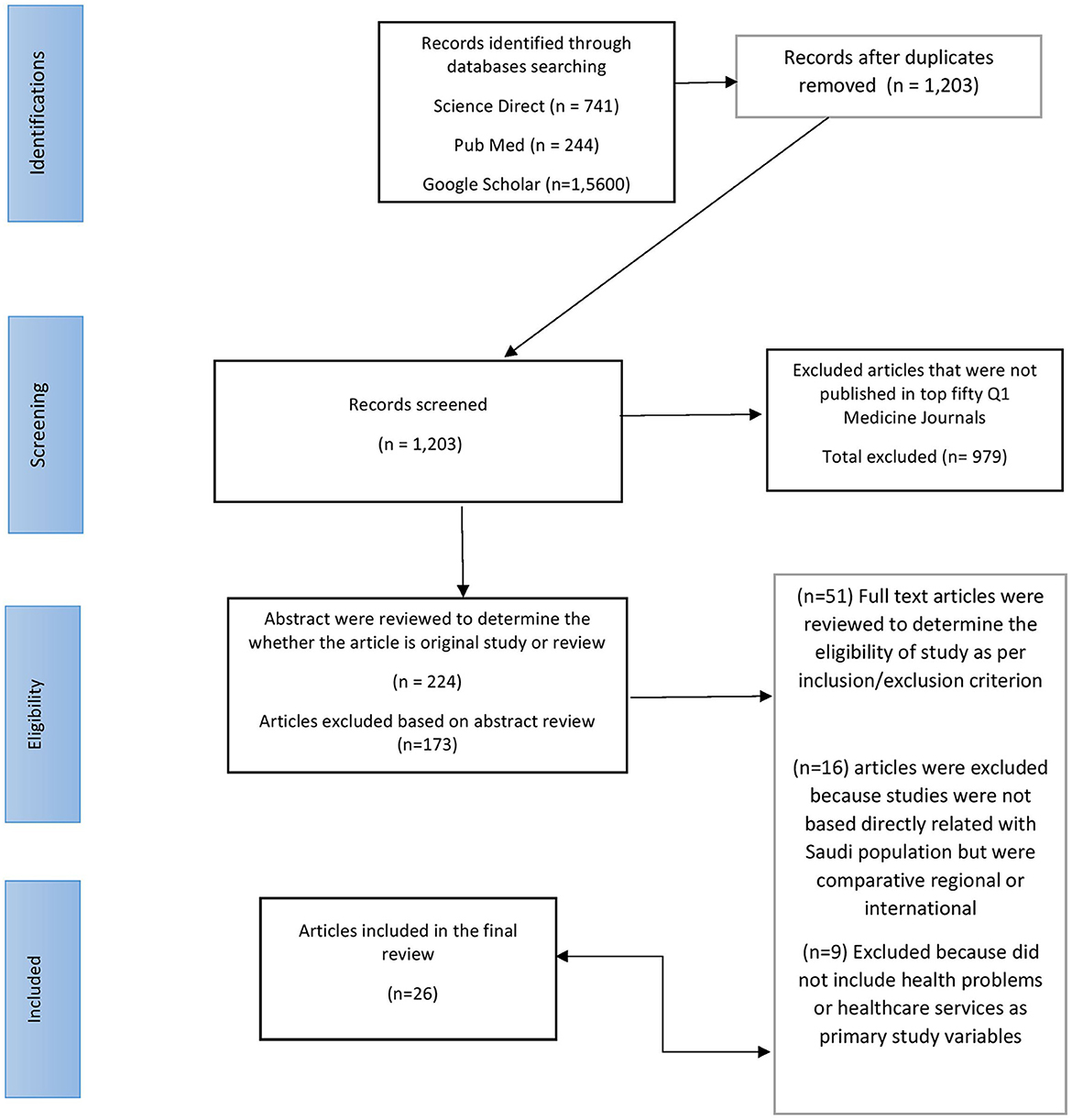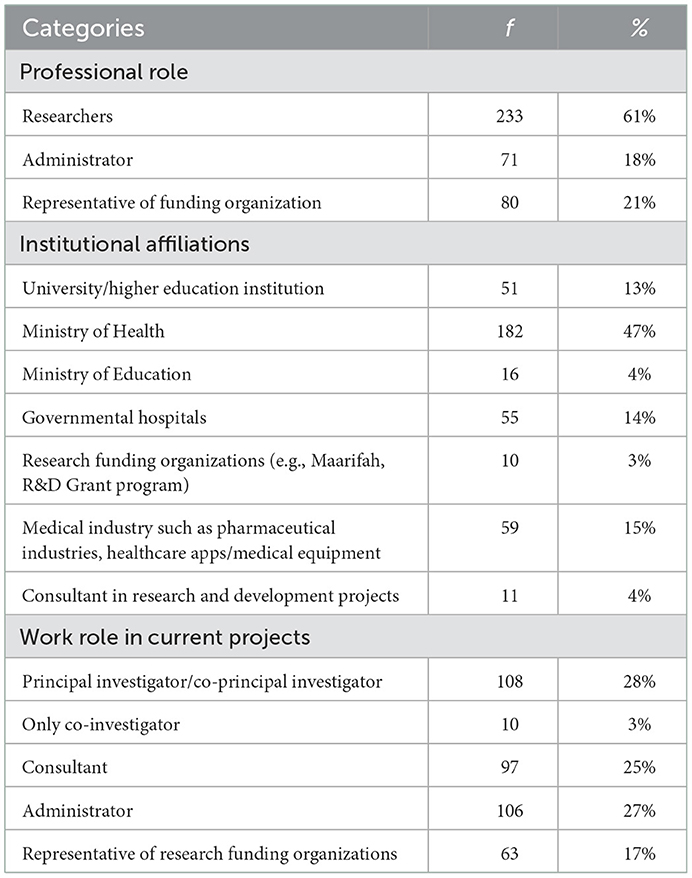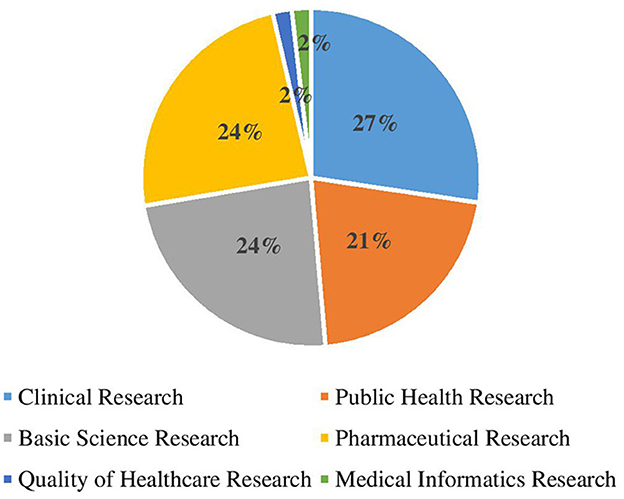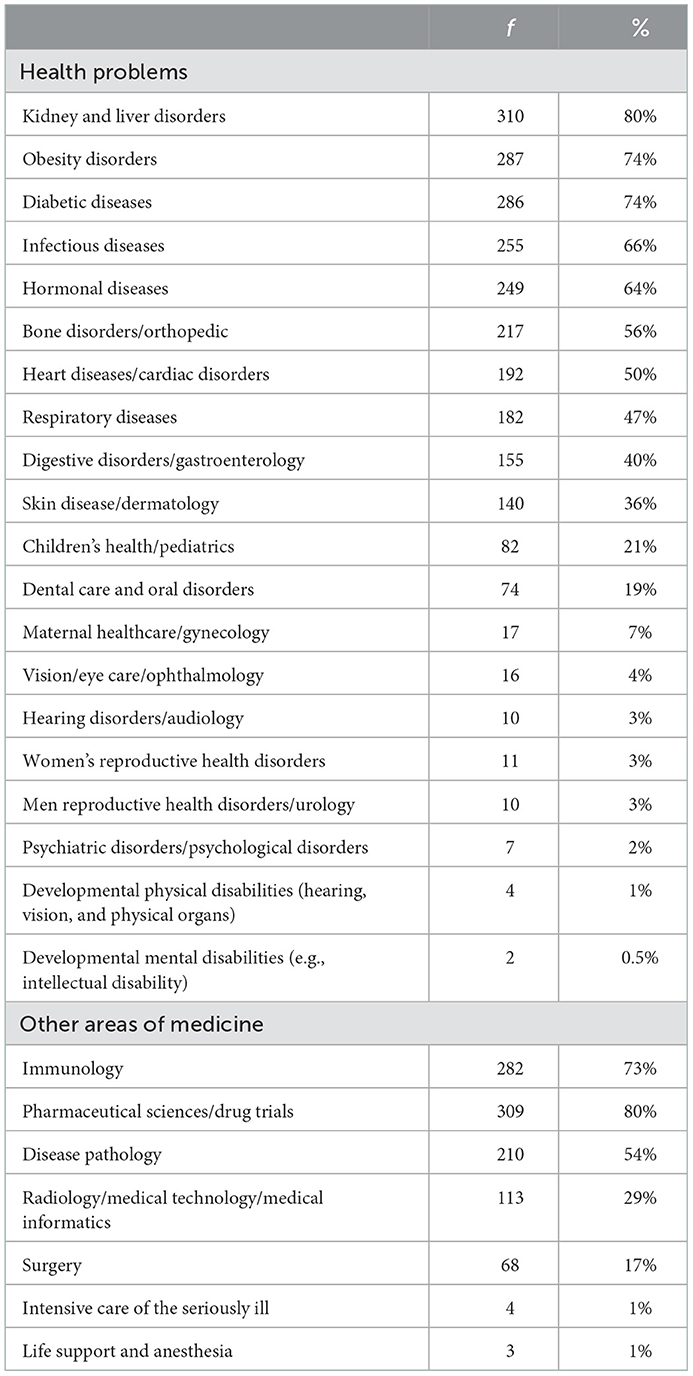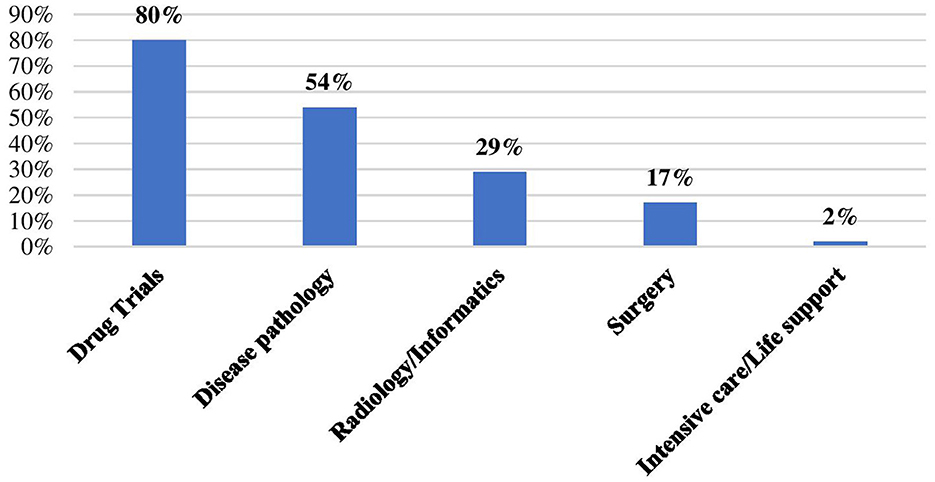- 1Department of Public Health, College of Public Health and Health Informatics, University of Ha'il, Ha'il, Saudi Arabia
- 2Department of Health Management, College of Public Health and Health Informatics, University of Ha'il, Ha'il, Saudi Arabia
- 3Department of Health Informatics, College of Public Health and Health Informatics, University of Ha'il, Ha'il, Saudi Arabia
Background: The identification of current gaps in high-impact medical research in Saudi Arabia has international significance due to the trend of collaborative research in the field of health and medicine and the focus on knowledge-sharing. The purpose of this study is to assess the current focus, gaps, and priorities in health research in Saudi Arabia.
Methods: We employed a mixed-method research approach to achieve research objectives. (1) a systematic review of scientific research studies that are published between January 2020 to January 2022 in the top fifty Q1 medical science journals (2) a cross-sectional survey collected data from professionals employed in various organizations including the Ministry of Health (MoH), Ministry of Education (MoE), health organizations and universities, and the health industry. The close-ended survey questions inquired about the broad and specific areas of ongoing health research projects by these researchers and organizations in Saudi Arabia.
Results: The literature search on databases identified Science Direct (n = 741), Pub Med (n = 244) and Google Scholar (n = 15,600). After screening, (n = 26) original studies were selected for detailed evaluation and synthesis. Among these (n = 7) studied infectious diseases, (n = 7) cancer, and cardiac disease (n = 5). These studies focused on the etiology, treatment management and therapy outcomes of these health conditions. The survey was completed by (n = 384) respondents from these organizations. Most of the ongoing research projects focus on clinical sciences (27%) followed by basic sciences (24%) and public health research (24%) and a limited number of researchers were involved in healthcare management (2%) and informatics (2%). Most research focused on kidney and liver disorders (80%), obesity (74%), diabetes (74%), hormonal diseases (64%), and infectious disease (66%); it is equally important to design and fund research in some of the neglected areas including reproductive health (3%), physical and mental disabilities (1%).
Conclusion: Findings suggest that current gaps in original research from Saudi Arabia are in healthcare service quality, reproductive health, physical and mental disabilities and health informatics. Researchers and funding agencies and international collaborative projects should prioritize these areas.
1. Introduction
The World Health Organization (WHO) urges global, regional, and local research to improve access and delivery of healthcare services to all sections of the population in accordance with their regional and national circumstances (1). The WHO's strategy for research on health is based on the claim that good quality scientific knowledge should be used to formulate policies and practices to promote global health. Health organizations and academic institutions in both developed and developing countries have focused on developing more human resources through research training. In recent times, local and international funding organizations have invested more funds in health research.
Research studies in the field of health sciences assess health problems, understand their causes, utilize the research findings to formulate policies, practices, and products; and evaluate the effectiveness of health interventions. Saudi 2030 vision also aims to devise efficient healthcare systems by expanding and improving the quality of healthcare services as well as financing health services to achieve universal health coverage. The Saudi government allocated both financial and human resources in scientific research to strengthen the procedures for data sharing and access to updated information and supported institutions and health organizations to conduct research, which is helpful in assessing their progress toward the Saudi 2030 vision. In 2015, more than 3.2 billion Saudi Riyal were invested in science and technology projects, out of which ~23% of the total funding went to medical and health research projects. In addition, the Ministry of Education (MoE) has taken nearly 24 initiatives to support research and development activities including research capital funding, university-industry partnership programs, international collaborations, research training, and knowledge-sharing platforms (2). Researcher organizations and researchers working on international collaborative projects need valid information to understand the existing gaps in health research to set the direction for future research projects and enhance the research output. It is, therefore, pertinent to assess the research outcomes, current focus, and future trends in health research in Saudi Arabia to monitor progress toward the research and development milestones of the Saudi 2030 vision.
Health research includes both healthcare and health services research, which relates to various fields, including life sciences, medical, psychological, social sciences, health informatics, and management sciences (3). The term “health research” was taken to cover both primary and secondary research, including clinical trials, field studies, cross-sectional surveys, community-based intervention studies, analyses of existing demographic and health data to develop health policies, and analytical research including systemic reviews and meta-analyses (4). According to the WHO (5) the guiding principle for successful health research includes the features of quality, impact, and inclusiveness. Good quality health research is concise in methodology, unbiased, ethical, carefully monitored and evaluated for adherence to procedures, and provides an accurate interpretation of the findings. The impact of health research is determined by its capacity to improve local and global health outcomes, address health inequities, and foster health-related development. Health research focuses on inclusiveness through collaboration between academia and industry and mainstream research by engaging the community in the research process. All these features make it possible to achieve the desired outcomes of health research.
Research productivity in the field of health sciences in the Saudi Arabia has been estimated by only a few previous studies. A bibliometric analysis of scientific research studies published between period of 2008–2017 were retrieved from the Scopus Database (6). A total of 35,291 articles were retrieved, with the highest number of publications during 2017, demonstrating rising trends in research output between 2008 and 2017 and a promising growth rate of 59% between 2014 and 2017. This review identified gaps in research in the fields of nursing and neuroscience. The major contributor among academic institutions for health research was King Saud University Saudi Arabia as demonstrated in previous research (7). The outcomes of initiatives taken by other institutions to improve research productivity in the past few years are not known.
A bibliometric analysis of research papers that were published between 1980 and 2014, demonstrated that (33%) of research articles published during this period were focused in area of clinical and health research (8). A review of health research published between 1996 and 2012 found 27,246 papers of which only 151 belonged to high-impact factor journals (9). A previous study from Saudi Arabia assessed biomedical research productivity between 1982 and 2000 by conducting another bibliometric analysis (10). A total of (n = 5,962) research articles were published in PubMed indexed journals from Saudi Arabia during this period. Out of total research that was contributed by countries from Arab sphere during this period, around 27% was by Saudi Arabia.
The current reliable estimates of high-impact research productivity in Saudi Arabia are limited to scholarly research published until 2017 (6, 11). There is one recent study which examined trend of international collaborations for research in Saudi Arabia between 2001 to 2022 and found that due to collaborative projects the average annual growth rate of scientific publications in Saudi Arabia was raised to 17% (12). Both these studies are based on bibliometric analysis and lacking the input/opinion of all stakeholders.
The current study adopts a mixed-method approach to gain deeper insight that will be useful for setting appropriate courses of action to achieve the research and development goals. The identification of current gaps in high-impact medical research in Saudi Arabia has international significance due to the trend of collaborative research in the field of health and medicine and focus on knowledge-sharing. According to recent estimates, 65% of Saudi Arabia's scientific output between in the past two decades involved international collaborations (12). International research organizations and researchers located in various countries could use the insight from this research to design appropriate proposals for international collaborative research projects.
The specific objectives of this study are as follows:
- To assess the current trends and existing gap in health science research in Saudi Arabia.
- To determine future priorities for scientific research in health science.
- To make suggestions for the re-formulation of health research strategies and international collaboration in specific area to enhance high-impact research productivity in Saudi Arabia.
2. Methods
2.1. Study design
The study employed a mixed-method research approach that included (1) a systematic review of high-impact scientific research studies published between January 2020 and January 2022 in the top fifty Q1 journals and (2) a cross-sectional survey of key stakeholders comprising researchers, administrators and key informants in organizations that fund clinical and public health research in Saudi Arabia conducted in March and April 2022.
2.2. Systematic review of high-impact original research in medicine from Saudi Arabia
The systematic review was completed using the PSALSAR framework which has six steps. The details of each step followed to complete this systematic review are presented in Table 1.
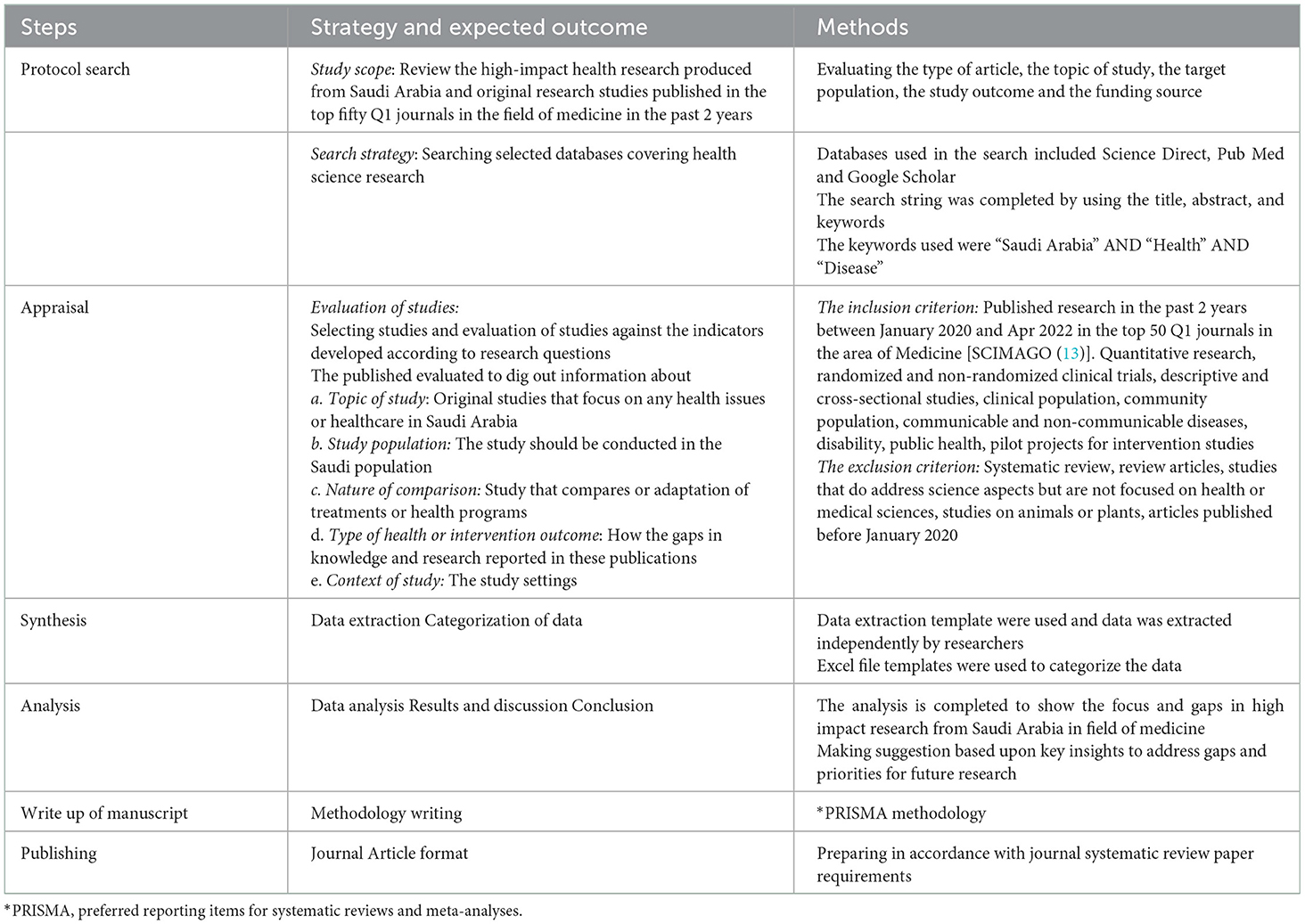
Table 1. PSALSAR framework utilized to conduct a systematic review of health research studies in Saudi Arabia.
2.3. Online survey method
2.3.1. Survey respondents
Data on the online survey form were collected from key informants and researchers working in various organizations in Saudi Arabia during the study period. These included administrators from the Ministry of Health (MoH) and the Ministry of Education (MoE), researchers and faculty from higher educational institutions/universities, governmental and non-governmental healthcare organizations, research funders, independent researchers in health organizations and universities, research consultants, staff in health industry involved in research and development projects. A total of (n = 384) professionals who were in any of the three given roles, namely a researcher, an administrator, or a representative of the funding organization/s, completed the survey forms.
2.3.2. Survey questionnaire
The survey questionnaire comprised three parts. The first part provided information about the study, assessed the prospective participant on the study inclusion/exclusion criteria, and obtained informed consent. Those who met the inclusion/exclusion criteria and consented to participate proceeded to the next screening of the survey form. In the second part of the survey, respondents provided information about their affiliation with the target organization from the given list of organizations and the current work role that relates with scientific research. The third part of the survey obtained information about the broad areas and specific types of health problems being studied in the respondents' ongoing research projects. The respondents were required to provide a yes or no response to all the areas and topics of health research presented in the survey form. A pilot survey was completed for the pre-testing of survey items to ensure their appropriateness. Both the English and Arabic versions of the survey form were presented, and respondents could choose their preferred language to complete the survey.
2.4. Study procedures
For a systematic review, the search was completed by two researchers, and data extraction was completed by two researchers independently using data extraction forms. The information was categorized into MS Excel sheets for synthesis and analysis. Data collection for the cross-sectional online survey was completed in March 2022 and April 2022. The survey was distributed using a Google Forms link, which was shared with the target research community through researchers and health professionals' online communities.
2.5. Data analysis
The synthesis and analysis of data from the systematic review were completed by following the PRISMA methodology, and the findings are presented accordingly using percentage values that match the descriptive nature of the study. The data were entered and analyzed with IBMSPSS v.25 and graphs were made using MS Excel.
2.6. Ethical considerations
The authors of this study adhered to the research ethics guidelines of the Heliniski Code of Conduct. Informed consent was obtained from the research participants, and the anonymity of the data was maintained at all stages of research in accordance with the ethical principles.
3. Results
3.1. Findings from systematic review of published research
A total of 16,585 articles were retrieved from two rounds of literature search that were completed in January 2022. The flowsheet diagram shows the process of article search and evaluation at different levels, including those published in target journals, topics, abstracts, methodologies, and populations (Figure 1).
The information extracted from the articles published in the top 50 Q1 medicine journals between January 2020 and January 2022 is shown in Table 2. It was observed that most of the studies published by research teams from this country were systematic review, metanalysis or not focused on human health conditions. Overall, a low number of original (n = 26) studies from Saudi Arabia were published in these journals during this period. Out of (n = 26) original studies, (n = 7) focused on infectious diseases, cancer (n = 7) cardiac disease (n = 5) particularly the etiology, treatment management, and therapy outcomes of these diseases. Other published studies focused on diabetes (n = 1), dental problems (n = 1), maternal health (n = 1), child obesity (n = 1), inherited disease condition (n = 1), emergency healthcare services (n = 1), and treatment protocol for amiodarone therapy (n = 1). Most of the published studies were funded by key organizations supporting scientific research in Saudi Arabia including the King Abdullah International Medical Research Center, King Abdullah bin Abdul-Aziz University, and some in collaboration with international funding agencies. Pharmaceutical research was funded by pharmaceutical companies such as Pfizer, AstraZeneca and, Genomic Health.
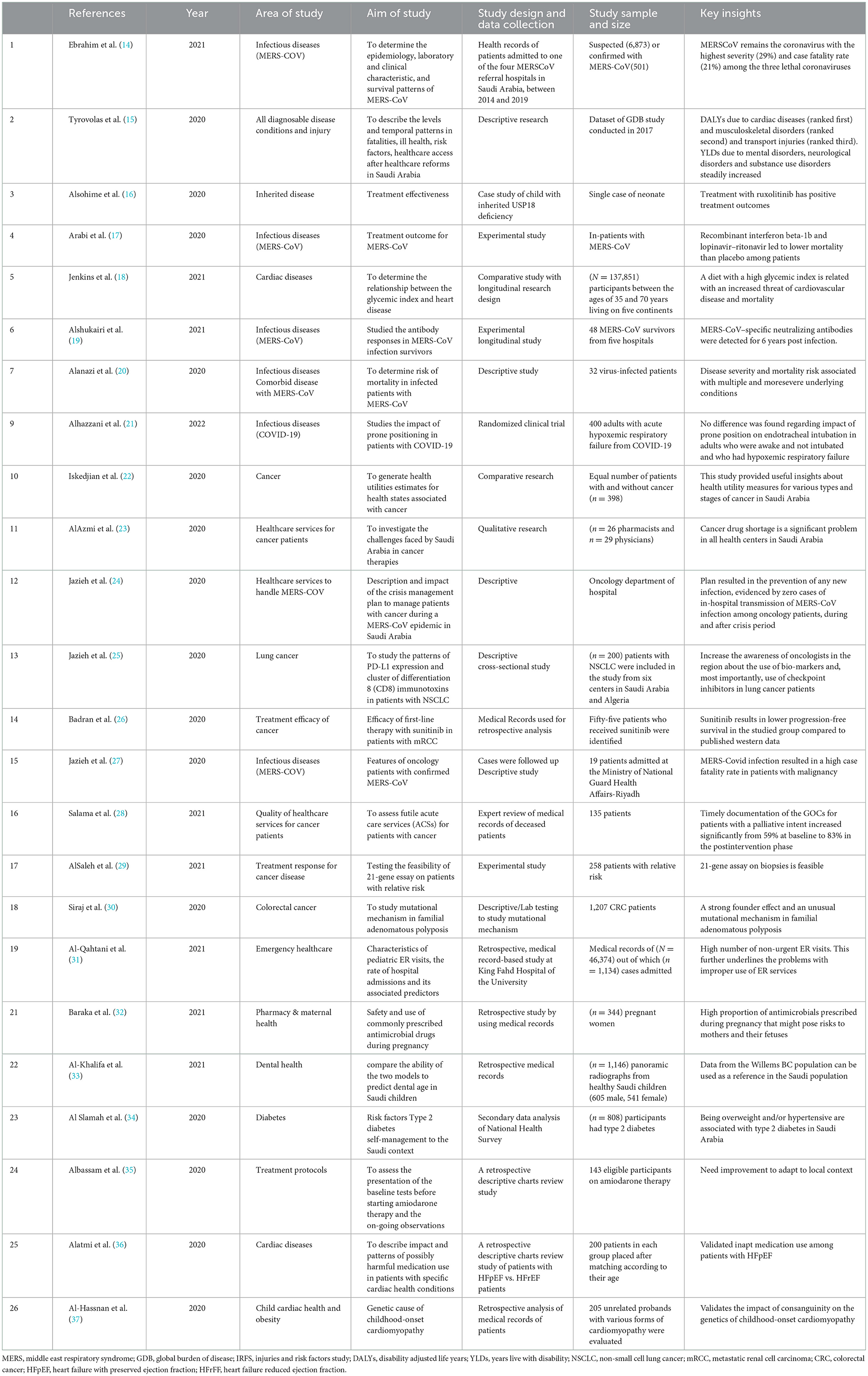
Table 2. Original research studies included in review published in top 50 Q1 journals between January 2020 to January 2022 (n = 26).
3.2. Findings from the cross-sectional survey
Among the respondents, 61% identified as researchers, whereas 21% were associated with organizations that fund the health research projects. Participants were involved with various organizations directly and indirectly implicated in research work, and the majority were affiliated with the MoH (47%). Among the researchers, 28% were working as principal investigators and co-investigators (Table 3).
The analysis of ongoing projects of respondents revealed that almost one-third of the current research focuses on clinical sciences; almost one-quarter of the research is focused on basic sciences (24%), and an equal proportion is on pharmaceutical sciences (24%), and basic sciences (21%). The analysis revealed that around 2% of current research focuses on the quality of healthcare and (2%) on medical informatics (Figure 2).
The findings (Table 4) demonstrate among ongoing research projects carried out by respondents are on various diseases, included kidney and liver disorders (80%), obesity (74%), diabetes (74%), hormonal diseases (64%), infectious diseases (66%), orthopedic (56%), cardiac disorders (50%), respiratory diseases (47%), and digestive disorders (40%). The health issues that are less studied on in the current research projects include developmental disorders, both mental and physical disabilities, and psychiatric disorders; statistics show that only around (1%) of ongoing research projects by researchers have focused on these areas. Fewer ongoing research projects focuses on maternal healthcare, and less than one-tenth of research focuses on men and women's reproductive health disorders (Table 4).
Among the specific areas of health research, 80% of current research projects are drug trials; over 50% of the ongoing research focuses on disease pathology (54%); nearly one-third of the studies focus on radiology and informatics (29%); and less than one-quarter focus on surgery (17%). Finally, few current research studies (2%) focus on intensive care and life support (Figure 3).
4. Discussion
The current study aimed to inspect the current focus, trends, and gaps in population health research in Saudi Arabia based on data obtained from a systematic review of high-impact journal publications in the past 2 years and a survey of research leaders to collect information about their ongoing research projects. The current study is significant because the Saudi government is moving toward a knowledge-based economy and has taken several initiatives over the past decade, such as research funding and collaborations with international research organizations for higher education, research and innovation (2). As a result, Saudi Arabia has experienced a significant increase in the number of publications in science journals. According to Saudi Gazette, Saudi Arabia ranked first in the Arab sphere in scientific research and 25th at the global level by the Scimago Index (13). It also reported an increase in the publication of scientific research to over 57,000 from local universities. Our study findings suggests that some of the important population health issues identified by the Global Burden of Diseases, Injuries, and Risk Factors Study (2017) (38) are the focus of ongoing research projects, and few original studies from Saudi Arabia were published in the top 50 Q1 journals in the field of medicine (Table 1). However, the protocol search also revealed that a substantial number of the articles published between January 2020 and January 2022 with affiliations of research organizations from universities in Saudi Arabia are based on meta-analyses and, systematic and non-systematic reviews of literature. The current study as well as previous literature (39) demonstrated the paucity of qualitative research that is published in high-impact medical research journals. There could be possibly different reasons for it such as the qualitative studies are time-consuming and are seen as less reliable evidence due to the subjective nature of the study. Moreover, it has been found that the rigor of qualitative research is considered as low because the sampling is usually based on convenience sampling and is less in number. These factors limit the generalizability of findings and discourage journals to publish qualitative research, which sometimes falls below the criterion used to assess the quality of research. After screening and evaluating, the population-based health studies that published and met the inclusion and exclusion criteria were limited to few. Thus, the current study strongly suggests the need to identify and address the challenges currently faced by researchers in conducting original studies and publishing research in the top high-impact journals. Lastly, there is need for a longitudinal analysis to determine the publication of qualitative research in high-impact medicine journals.
Our findings show that a smaller number of ongoing research projects have focused on maternal health, reproductive health, and developmental disabilities. This finding aligns with the previous literature (6, 38); which demonstrated that less funding and research resources are allocated for research projects in the area of maternal and infant health, and there is a need to address the existing gaps in the research and set these issues as priorities for future research. The findings also revealed that current research focuses less on studying psychological and behavioral problems, even though it has noticed a steady rise in years lived with a disability in Saudi Arabia due to psychiatric and substance abuse disorders between 2010 and 2017 (15). The authors of this study have noticed that several cross-sectional surveys were conducted during the COVID-19 pandemic to study its psychological and emotional repercussions (40, 41). However, to publish in the top Q1 journals, robustness must be adopted in research methodology and in reporting findings that are compromised due to limited resources to conduct and publish research. These challenges should be addressed to over-come the existing gaps in high-impact research in the health sciences.
Finally, the findings from the survey also demonstrated that a limited number of current projects study issues related to healthcare management and medical informatics. Since Saudi Arabia has adopted several health reforms and automation of healthcare systems, it is important to allocate more resources to study how this automation is increasing the efficiency of healthcare systems, as well as the challenges faced by the healthcare force and patients.
4.1. Study strengths, limitations, and directions for future research
This study adopted a mixed-method approach to conduct a comprehensive analysis of the current focus of scientific research on population health in Saudi Arabia. A systematic review of studies published in high-impact journals and a cross-sectional survey of key players in the field was an effective research methodology to accomplish the research objectives and provide useful insights. The current study's findings are helpful in identifying existing gaps in health research and making recommendations for future research priorities. The findings demonstrate some of the positive outcomes of initiatives taken by the Saudi MoH and MoE to promote scientific research in Saudi Arabia in the past decade, as a result, few important original studies were published in the top high-impact medical journals. Original scientific studies in the field of medicine require labs, technological equipment, and appropriate research training, along with the enhancement of critical thinking and creative abilities, to develop leaders in scientific research in Saudi Arabia. Therefore, the study findings underline the need to invest in these areas, and such measures will be effective in enhancing the outcomes of existing research initiatives and smooth progress to achieve the Saudi 2030 vision. Among the study limitations, the current systematic review limited the analysis to the specific period of the last 4 years and the top 50 high-impact journals. In addition, the cross-sectional survey comprised of close-ended questions and thus a detailed assessment of underlying reasons for the lack of research on certain topics were not conducted. Qualitative studies are needed to identify obstacles and issues that must be addressed to prioritize research areas. Qualitative studies are recommended in the future to obtain the opinions of leaders in scientific research, which will be useful in formulating strategic plans and addressing the existing gaps in health research. Understanding the needs and roles of stakeholders will provide more insight to overcome barriers and appropriate actions to achieve research and development goals, the ensure the availability of adequate resources at an institutional level to conduct such studies. Globally, research is being conducted at a fast pace, and it is necessary to design research that identifies, the specific reasons restricting the production and publication of high-impact health research in Saudi Arabia. Some of the priorities for future research funding in the health sciences in Saudi Arabia should focus on health issues such as physical and mental disabilities, reproductive health, maternal health and dental disorders. In additions, original studies should be funded to assess progress and development on health informatics and the quality of healthcare services in Saudi Arabia.
5. Conclusion
In conclusion, some of the important studies that have been conducted in the last decade on MERS-CoV, cancer and cardiac diseases in Saudi Arabia were published in few top high-impact science journals. This number must be increased further, and future research should focus on identifying the key reasons to address this gap. It is a positive development that most of the ongoing research projects focus on major health problems in the Saudi population such as kidney and liver diseases, obesity, diabetes and hormonal diseases. However, there are some existing gaps in research in some specific areas such as physical and mental disabilities, dental diseases and reproductive health problems should also be considered in future research. The impact of major developments in the healthcare industry, such as the expansion of health informatics systems and the delivery of healthcare services should also be investigated to devise appropriate healthcare policies and procedures.
Data availability statement
The original contributions presented in the study are included in the article/supplementary material, further inquiries can be directed to the corresponding author.
Ethics statement
The studies involving human participants were reviewed and approved by Ethical Review Committee University of Ha'il. The patients/participants provided their written informed consent to participate in this study.
Author contributions
Conceptualization, systematic review, data analysis, write-up, and review and revision: AA-S. Systematic review, data analysis, write up, and review and revision: SH. Data collection, data extraction, and review and revision: FA. Systematic review, data extraction, review and revision, and references: MA. All authors contributed to the article and approved the submitted version.
Conflict of interest
The authors declare that the research was conducted in the absence of any commercial or financial relationships that could be construed as a potential conflict of interest.
Publisher's note
All claims expressed in this article are solely those of the authors and do not necessarily represent those of their affiliated organizations, or those of the publisher, the editors and the reviewers. Any product that may be evaluated in this article, or claim that may be made by its manufacturer, is not guaranteed or endorsed by the publisher.
References
2. Meo SA. Saudi Arabia: a future regional hub for advanced education, research, science and technology. J Pak Med Assoc. (2015) 65:1112–5.
3. Institute of Medicine (US) Committee on Health Research and the Privacy of Health. Beyond the HIPAA Privacy Rule Enhancing Privacy, Improving Health Through Research; Nass SJ, Levit LA, Gostin LO, editors. Washington, DC: National Academies Press (2009).
4. Yao Q, Lyu P-H, Yang L-P, Yao L, Liu Z-Y. Current performance and future trends in health care sciences and services research. Scientometrics. (2014) 101:751–79. doi: 10.1007/s11192-014-1383-7
5. World Health Organization. European Advisory Committee on Health Research: Fourth Meeting, Copenhagen, Denmark, 10–11 December 2013. Geneva: World Health Organization. Regional Office for Europe (2014).
6. Ul Haq I, Ur Rehman S, Al-Kadri HM, Farooq RK. Research Productivity in the Health Sciences in Saudi Arabia: 2008-2017. Ann Saudi Med. (2020) 40:147–54. doi: 10.5144/0256-4947.2020.147
7. Gadhouma Y, Karamb Y. The determinants of research productivity in public vs. private Saudi universities. Asia Pac J Adv Bus Soc Stud. (2016) 2:625–60.
8. Shehatta I, Mahmood K. Research Collaboration in Saudi Arabia 1980–2014: bibliometric patterns and national policy to foster research quantity and quality. Libri. (2016) 66:13–29. doi: 10.1515/libri-2015-0095
9. Meo SA, Hassan A, Usmani AM. Research progress and prospects of Saudi Arabia in global medical sciences. Eur Rev Med Pharmacol Sci. (2013) 17:3265–71.
10. Tadmouri GO, Tadmouri NB. Biomedical research in the kingdom of Saudi Arabia (1982-2000). Saudi Med J. (2002) 23:20–4.
11. Latif R. Medical and biomedical research productivity from the kingdom of Saudi Arabia (2008-2012). J Family Community Med. (2015) 22:25. doi: 10.4103/2230-8229.149583
12. Babour A, Alzamzami O, Adedayo AV, Kuzhabekova A. International publication trends and collaboration impact on the scientific research of Saudi Arabia. J Scientometr Res. (2021) 10:328–36. doi: 10.5530/jscires.10.3.49
13. SCIMAGO. Saudi Universities Contribute 93% of the Kingdom's Scientific Research. Available online at: https://www.scimagojr.com/journalrank.php?area=2700 (accessed January 1, 2022).
14. Ebrahim SH, Maher AD, Kanagasabai U, Alfaraj SH, Alzahrani NA, Alqahtani SA, et al. MERS-CoV confirmation among 6,873 suspected persons and relevant epidemiologic and clinical features, Saudi Arabia–2014 to 2019. EClinicalMedicine. (2021) 41:101191. doi: 10.1016/j.eclinm.2021.101191
15. Tyrovolas S, El Bcheraoui C, Alghnam SA, Alhabib KF, Almadi MAH, Al-Raddadi RM, et al. The burden of disease in Saudi Arabia 1990–2017: results from the global burden of disease study 2017. Lancet Planet Heal. (2020) 4:e195–208. doi: 10.1016/S2542-5196(20)30075-9
16. Alsohime F, Martin-Fernandez M, Temsah M-H, Alabdulhafid M, Le Voyer T, Alghamdi M, et al. Inhibitor therapy in a child with inherited USP18 deficiency. N Engl J Med. (2020) 382:256–65. doi: 10.1056/NEJMoa1905633
17. Arabi YM, Asiri AY, Assiri AM, Balkhy HH, Al Bshabshe A, Al Jeraisy M, et al. Interferon Beta-1b and lopinavir–ritonavir for middle east respiratory syndrome. N Engl J Med. (2020) 383:1645–56. doi: 10.1056/NEJMoa2015294
18. Jenkins DJA, Dehghan M, Mente A, Bangdiwala SI, Rangarajan S, Srichaikul K, et al. Glycemic index, glycemic load, and cardiovascular disease and mortality. N Engl J Med. (2021) 384:1312–22. doi: 10.1056/NEJMoa2007123
19. Alshukairi AN, Zhao J, Al-Mozaini MA, Wang Y, Dada A, Baharoon SA, et al. Longevity of middle east respiratory syndrome coronavirus antibody responses in humans, Saudi Arabia. Emerg Infect Dis. (2021) 27:1472. doi: 10.3201/eid2705.204056
20. Alanazi KH, Abedi GR, Midgley CM, Alkhamis A, Alsaqer T, Almoaddi A, et al. Diabetes mellitus, hypertension, and death among 32 patients with MERS-CoV infection, Saudi Arabia. Emerg Infect Dis. (2020) 26:166. doi: 10.3201/eid2601.190952
21. Alhazzani W, Parhar KKS, Weatherald J, Al Duhailib Z, Alshahrani M, Al-Fares A, et al. Effect of awake prone positioning on endotracheal intubation in patients with COVID-19 and acute respiratory failure: a randomized clinical trial. JAMA. (2022) 21:2014–113. doi: 10.1001/jama.2022.13994
22. Iskedjian M, De Vol E, Elshenawy M, Bazarbashi S Elicitation Elicitation of health utilities in oncology in the Kingdom of Saudi Arabia. JCO Glob Oncol. (2020) 6:1609–1616. doi: 10.1200/GO.20.00234
23. AlAzmi AA, Jastaniah W, Alhamdan HS, AlYamani AO, AlKhudhyr WI, Abdullah SM, et al. Addressing cancer treatment shortages in Saudi Arabia: results of a national survey and expert panel recommendations. JCO Glob Oncol. (2020) 6:476–85. doi: 10.1200/JGO.19.00230
24. Jazieh A-R, Al Hadab A, Al Olayan A, AlHejazi A, Al Safi F, Al Qarni A, et al. Managing oncology services during a major coronavirus outbreak: lessons from the Saudi Arabia experience. JCO Glob Oncol. (2020) 6:518–24. doi: 10.1200/GO.20.00063
25. Jazieh AR, Bounedjar A, Bamefleh H, Alfayea T, Almaghraby HQ, Belarabi A, et al. Expression of immune response markers in Arab patients with lung cancer. JCO Glob Oncol. (2020) 6:1218–24. doi: 10.1200/GO.20.00107
26. Badran A, Elshenawy MA, Shahin A, Aljubran A, Alzahrani A, Eldali A, et al. Efficacy and prognostic factors of sunitinib as first-line therapy for patients with metastatic renal cell carcinoma in an Arab population. JCO Glob Oncol. (2020) 6:19–26. doi: 10.1200/JGO.19.00111
27. Jazieh A-R, Alenazi TH, Alhejazi A, Al Safi F, Al Olayan A. Outcome of oncology patients infected with coronavirus. JCO Glob Oncol. (2020) 6:471–5. doi: 10.1200/GO.20.00064
28. Salama H, Al Mutairi N, Damlaj M, Alolayan A, Binahmed A, Salama H, et al. Reducing futile acute care services for terminally ill patients with cancer: the dignity project. JCO Oncol Pract. (2021) 17:e1794–802. doi: 10.1200/OP.20.00922
29. AlSaleh K, Al Zahwahry H, Bounedjar A, Oukkal M, Saadeddine A, Mahfouf H, et al. Response to induction neoadjuvant hormonal therapy using upfront 21-gene breast recurrence score assay—results from the SAFIA phase III trial. JCO Glob Oncol. (2021) 7:811–9. doi: 10.1200/GO.20.00575
30. Siraj AK, Masoodi T, Bu R, Parvathareddy SK, Siraj S, Alassiri A, et al. The study of lynch syndrome in a special population reveals a strong founder effect and an unusual mutational mechanism in familial adenomatous polyposis. Gut. (2020) 69:2048–9. doi: 10.1136/gutjnl-2019-320511
31. Al-Qahtani MH, Yousef AA, Awary BH, Albuali WH, Al Ghamdi MA, AlOmar RS, et al. Characteristics of visits and predictors of admission from a paediatric emergency room in Saudi Arabia. BMC Emerg Med. (2021) 21:1–8. doi: 10.1186/s12873-021-00492-6
32. Baraka MA, AlLehaibi LH, AlSuwaidan HN, Alsulaiman D, Islam M, Alotaibi BS, et al. Patterns of infections and antimicrobial drugs' prescribing among pregnant women in Saudi Arabia: a cross sectional study. J Pharm Policy Pract. (2021) 14:1–10. doi: 10.1186/s40545-020-00292-6
33. Al-Khalifa KS, Bakhurji E, Halawany HS, Alabdurubalnabi EM, Nasser WW, Shetty AC, et al. Pattern of dental needs and advice on twitter during the COVID-19 pandemic in Saudi Arabia. BMC Oral Health. (2021) 21:1–7. doi: 10.1186/s12903-021-01825-4
34. Al Slamah T, Nicholl BI, Alslail FY, Harris L, Kinnear D, Melville CA, et al. Correlates of type 2 diabetes and glycaemic control in adults in Saudi Arabia a secondary data analysis of the saudi health interview survey. BMC Public Health. (2020) 20:1–13. doi: 10.1186/s12889-020-08597-6
35. Albassam BA, Almutairi NM, Aldosari SF, Almodaimegh HS. Compliance with the North American society of pacing and electrophysiology guidelines on amiodarone monitoring in riyadh, Saudi Arabia: a retrospective charts review study. J Pharm Policy Pract. (2020) 13:1–5. doi: 10.1186/s40545-020-00235-1
36. Alatmi S, Alburikan K, Alkofide H. Potentially inappropriate medication use among patients with heart failure preserved vs. reduced ejection fraction at an Academic Medical Center in Riyadh, Saudi Arabia. J Am Coll Cardiol. (2020) 75(11_Supplement_1):920. doi: 10.1016/S0735-1097(20)31547-3
37. Al-Hassnan ZN, Almesned A, Tulbah S, Alakhfash A, Alhadeq F, Alruwaili N, et al. Categorized genetic analysis in childhood-onset cardiomyopathy. Circ Genomic Precis Med. (2020) 13:504–14. doi: 10.1161/CIRCGEN.120.002969
38. Gakidou E, Afshin A, Abajobir AA, Abate KH, Abbafati C, Abbas KM, et al. Global, regional, and national comparative risk assessment of 84 behavioural, environmental and occupational, and metabolic risks or clusters of risks, 1990–2016: a systematic analysis for the global burden of disease study 2016. Lancet. (2017) 390:1345–422. doi: 10.1016/S0140-6736(17)32366-8
39. Gagliardi AR, Dobrow MJ. Paucity of qualitative research in general medical and health services and policy research journals: analysis of publication rates. BMC Health Serv Res. (2011) 11:268. doi: 10.1186/1472-6963-11-268
40. AlAteeq DA, Aljhani S, Althiyabi I, Majzoub S. Mental health among healthcare providers during coronavirus disease (COVID-19) outbreak in Saudi Arabia. J Infect Public Health. (2020) 13:1432–7. doi: 10.1016/j.jiph.2020.08.013
Keywords: medical research, gaps, trends, health research, Saudi Arabia, mixed-method analysis
Citation: AL-Shammary AA, Hassan Su-N, Alshammari FS and Alshammari MRR (2023) A mixed-method analysis to identify the current focus, trends, and gaps in health science research in Saudi Arabia. Front. Public Health 10:1028361. doi: 10.3389/fpubh.2022.1028361
Received: 04 September 2022; Accepted: 29 December 2022;
Published: 13 January 2023.
Edited by:
Michal Grivna, United Arab Emirates University, United Arab EmiratesReviewed by:
Kamal Ali, Al Zaiem Al Azhari University, SudanSyed Mahmood, King Khalid University, Saudi Arabia
Copyright © 2023 AL-Shammary, Hassan, Alshammari and Alshammari. This is an open-access article distributed under the terms of the Creative Commons Attribution License (CC BY). The use, distribution or reproduction in other forums is permitted, provided the original author(s) and the copyright owner(s) are credited and that the original publication in this journal is cited, in accordance with accepted academic practice. No use, distribution or reproduction is permitted which does not comply with these terms.
*Correspondence: Sehar un-Nisa Hassan,  cy5uaXNhQHVvaC5lZHUuc2E=
cy5uaXNhQHVvaC5lZHUuc2E=
 Asma Ayyed AL-Shammary
Asma Ayyed AL-Shammary Sehar un-Nisa Hassan
Sehar un-Nisa Hassan Fahad Saud Alshammari2
Fahad Saud Alshammari2